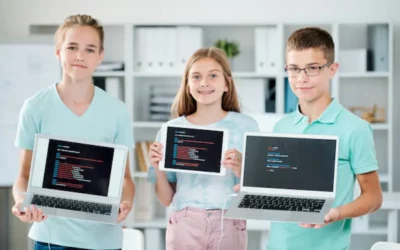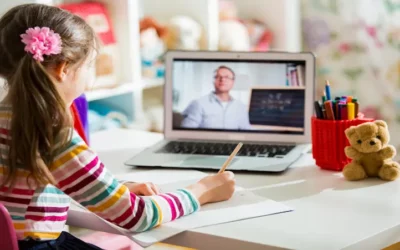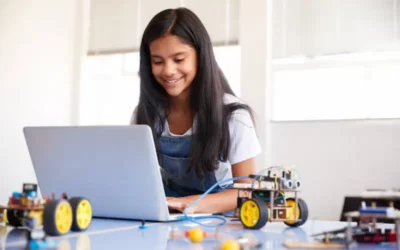In today’s digital age, coding has become an essential skill that can open many doors of opportunities for our kids. However, the high cost of online coding courses & programs for kids often makes them inaccessible to many, leaving them behind in the race to acquire these skills.
But what if we told you that there is a way to unlock your child’s creativity without burning a hole in your pocket? That’s right, free coding for kids is here, and it’s taking the world by storm!
In this blog post, we will explore everything about free coding. So, whether your child wants to create their own website or build an app, let’s discover how free coding can help them unleash their creativity!
Before diving into the blog, check out this video below.
Table of contents
- Introduction to free coding for kids
- The Benefits of Learning Coding for Kids
- Free MIT resources for coding
- Interactive Coding Websites for Kids
- Free Coding languages for Kids
- Free coding apps for Kids
- YouTube Channels for Kid-Friendly Coding Tutorials
- Free Coding Projects for Kids
- Coding Games for Kids
- Tips for Teaching Free Coding to Kids
- Offline Activities for Coding Exploration
- Free Coding Resources for Parents
- Applying coding skills to real-world problems
- Conclusion
- Frequently Asked Questions
Introduction to free coding for kids
Free Coding for Kids is a cost-free program that teaches children computer science and technology in an engaging manner. Such programs are often available online or through community organizations, and can help develop problem-solving skills, potentially leading to future careers in tech.
Encouraging children to learn coding can foster critical thinking and problem-solving abilities, boost creativity and innovation, and prepare them for the rapidly evolving job market. Free coding education can also promote equal access to technology education, creating opportunities for all.
The Benefits of Learning Coding for Kids
Learning coding at a young age offers numerous benefits for kids. Here are some of the key advantages:
- Problem-solving skills: Coding helps children develop critical thinking and problem-solving abilities. They learn to break down complex problems into smaller, manageable parts and use logical reasoning to find solutions.
- Creativity and innovation: Coding encourages kids to think creatively and explore their imagination. It empowers them to create and build things, fostering their innovation and allowing them to bring their ideas to life.
- Computational thinking: Coding teaches computational thinking, which involves understanding how to approach and solve problems in a structured and logical way. It enhances their ability to analyze information, organize data, and make informed decisions.
- Logical reasoning: Coding requires logical thinking and reasoning skills. Kids learn how to develop step-by-step instructions and follow logical sequences, enhancing their logical reasoning abilities.
- Persistence and resilience: Programming often involves trial and error. Kids learn to persevere through challenges, debug their code, and find solutions to problems. This fosters resilience and a growth mindset, teaching them that perseverance leads to success.
- Math and science skills: Coding involves mathematical concepts and scientific principles. Through coding, kids can reinforce their understanding of math and science, such as geometry, algebra, and physics, in a practical and engaging way.
- Collaboration and teamwork: Many coding projects require collaboration and teamwork. Kids learn how to work together, share ideas, and communicate effectively to achieve a common goal, promoting valuable social skills.
- Future job prospects: Coding skills are increasingly in demand in today’s digital world. By learning to code early on, kids gain a head start in acquiring valuable skills that can lead to diverse career opportunities in technology and computer science fields.
- Confidence and empowerment: As kids learn to code, they gain confidence in their abilities to solve problems and create things independently. It empowers them to take control of technology and become creators rather than passive consumers.
- Digital literacy: Coding provides a foundation for digital literacy, equipping kids with a deeper understanding of how technology works and enabling them to navigate the digital world with knowledge and awareness.
Overall, learning coding at a young age provides kids with a range of cognitive, problem-solving, and future-oriented skills, while fostering creativity, critical thinking, and empowerment.
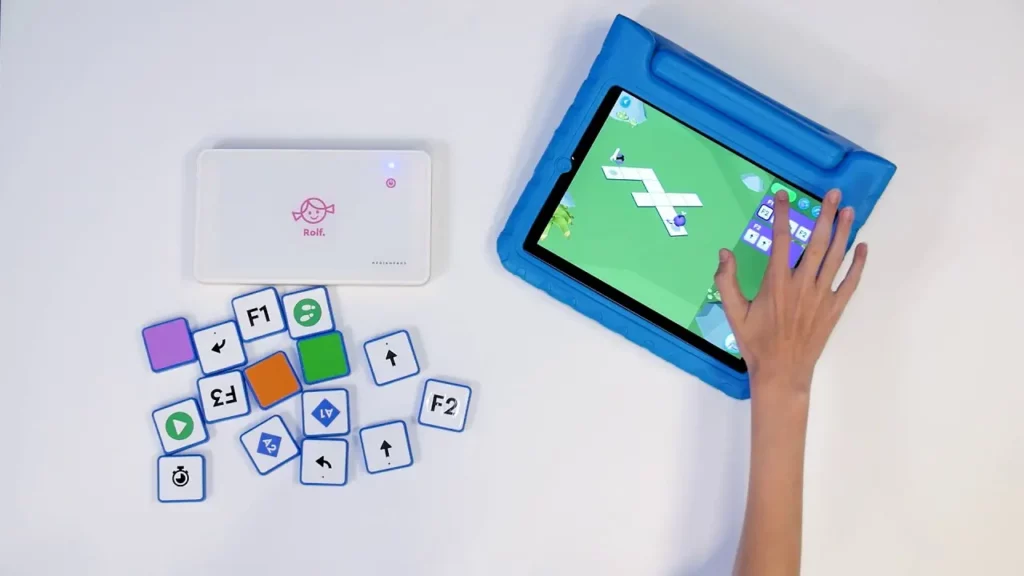
Free MIT resources for coding
MIT offers a great way to teach your kids how to code. Its extensive range of free resources includes Scratch, a block-based programming language that makes coding for beginners easy to learn & grasp concepts quickly.
Additionally, App Inventor enables kids to create their mobile apps without any prior experience in programming languages like Python or JavaScript. MIT also provides self-paced online courses and tutorials that cater to all experience levels from beginners to advanced programmers looking for more challenging material.
Helps kids to learn programming in a fun and interactive way with coding games for kids.
Interactive Coding Websites for Kids
- Code.org (code.org): Code.org offers a wide range of coding courses and activities for kids of all ages. It features block-based programming languages like Scratch and App Inventor, as well as text-based coding languages like Python and JavaScript. The website includes interactive tutorials, games, and projects to help kids learn coding concepts.
- Scratch (scratch.mit.edu): Scratch is a visual programming language developed by MIT. It allows kids to create interactive stories, games, and animations by snapping together blocks of code. Scratch features a vibrant online community where kids can share their projects and explore creations made by others.
- Tynker (tynker.com): Tynker is a coding platform that offers interactive coding lessons, games, and projects for kids. It provides a visual programming interface where kids can learn coding concepts by solving puzzles and creating their own games and animations. Tynker also offers courses on robotics and game design.
- CodeCombat (codecombat.com): CodeCombat is an online game that teaches coding through a fantasy-themed adventure. Kids write code to control their in-game characters and solve coding challenges. The game gradually introduces concepts like loops, variables, and functions, making it an engaging way to learn programming.
- Bitsbox (bitsbox.com): Bitsbox is a subscription-based service that delivers coding projects and materials to kids every month. It uses a combination of physical materials and an online coding environment to teach kids how to build their own mobile apps. Bitsbox offers step-by-step instructions and allows kids to see their apps come to life on real devices.
These interactive coding websites provide a hands-on and playful learning experience for kids, allowing them to explore coding concepts, experiment with code, and develop their coding skills in an interactive and enjoyable manner.
Free Coding languages for Kids
Encouraging kids to learn programming can be a fun way to introduce them to tech concepts. Beginners can start from scratch with BrightCHAMPS’s free resources in game development or web programming using HTML/CSS.
Hands-on coding is the best way to teach free coding to kids. These activities improve problem-solving skills, critical thinking skills, creativity, and imagination. Parents and teachers have access to many free resources online that make it easy to introduce children of all experience levels to coding.
From scratch programming classes for kids and tutorials to Python programming classes, there are plenty of options available. More advanced students can try visual programming languages like Python or JavaScript to create animations or interactive websites. Online coding classes offered by MIT etc. are great resources for learning computer science skills.

Free coding apps for Kids
Free coding for kids is an excellent way to unlock creativity while developing important problem-solving and critical-thinking skills. There are numerous free tutorials on Scratch programming, HTML for kids & CSS, and Python programming available for hands-on learning.
There are several free coding apps available that cater specifically to kids and provide a fun and interactive way to learn to code. Here are some popular options:
- ScratchJr: ScratchJr is a free coding app designed for young children (ages 5-7). It uses colorful blocks to create animations, interactive stories, and games. Kids can snap together blocks of code to control characters and objects, fostering their creativity and problem-solving skills.
- CodeSpark Academy: CodeSpark Academy offers a free coding app called “The Foos”. It introduces young kids (ages 4-9) to coding concepts through interactive games and puzzles. Kids can drag and drop commands to guide cute characters through various challenges.
- Tynker: Tynker, in addition to its web-based platform, also offers a free coding app for kids. It provides a range of coding activities, games, and projects suitable for different age groups (ages 5 and up). Kids can learn programming concepts while creating games, animations, and interactive stories.
- Kodable: Kodable is a free coding app designed for kids (ages 4-10) to learn programming fundamentals. It uses a visually appealing interface and game-like elements to engage kids in solving coding challenges. The app gradually introduces concepts like loops, conditionals, and functions.
- Lightbot: Lightbot is a free puzzle game app that teaches kids (ages 4 and up) programming logic. The objective is to guide a robot through a series of tiles using programming commands. Kids learn concepts such as sequencing, loops, and conditionals while completing levels.
These free coding apps offer a variety of activities and games that make learning coding enjoyable and accessible for kids. They provide hands-on experiences, encourage problem-solving skills, and introduce coding concepts in a playful and engaging manner.
YouTube Channels for Kid-Friendly Coding Tutorials
Tutorials or videos play a significant role in helping children learn about free game coding for kids. These online resources provide a great way for children to develop their programming skills by teaching them about the basics of different programming languages.
With resources ranging from animation to app development available online on many platforms like BrightCHAMPS‘ coding classes or Code.org’s Hour of Code series program; it provides children with hands-on experience with block-based coding while making it fun and interactive.
There are several YouTube channels dedicated to providing kid-friendly coding tutorials and resources. Here are some popular channels:
- Code.org (YouTube Channel: Code.org): Code.org’s YouTube channel features a variety of coding tutorials and resources for kids of all ages. It includes videos that introduce coding concepts, showcase coding projects, and provide step-by-step instructions for coding activities. The channel also features interviews with professionals in the tech industry.
- Scratch (YouTube Channel: Scratch Team): The Scratch Team’s YouTube channel offers a collection of videos related to the Scratch programming language. It includes tutorials on creating animations, games, and interactive stories using Scratch. The channel also features showcases of projects created by the Scratch community.
- CS First (YouTube Channel: CSFirst): CS First is a Google initiative that provides coding resources for kids. Its YouTube channel offers video tutorials on coding topics such as game design, storytelling, and music. The tutorials are designed to accompany the CS First curriculum but can be used independently as well.
- The Coding Train (YouTube Channel: The Coding Train): The Coding Train channel, hosted by Daniel Shiffman, offers coding tutorials with a focus on creative coding and visual programming. While not specifically targeted at kids, the channel’s engaging style and visual demonstrations make it accessible and enjoyable for young learners interested in coding and programming.
- Kids Coding TV (YouTube Channel: Kids Coding TV): Kids Coding TV offers coding tutorials and educational content designed specifically for kids. The channel covers various coding languages and concepts, including Scratch, Python, JavaScript, and more. It provides step-by-step instructions and interactive coding challenges to help kids learn and practice coding skills.
These YouTube channels provide a wealth of kid-friendly coding tutorials and resources, making it easier for children to learn coding concepts, practice their skills, and explore the world of programming in an engaging and accessible way.
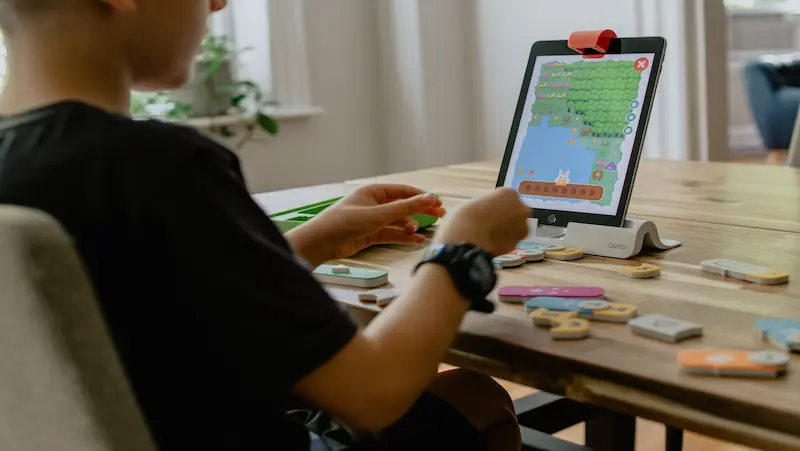
Free Coding Projects for Kids
Learning to code may seem daunting for kids but free coding projects can make it an enjoyable experience.
- Make a Board Game
Developing a board game is very similar to developing a game coded on a computer. So, making a physical board game can be the first fantastic project that still teaches kids, especially some core coding concepts. This allows kids to understand how to set up instructions to receive a certain outcome, and how every instruction comes together to create a cohesive project.
- Create a Random Generator
This involves setting up a simple array of objects and then using the array index to select a random element from the array to print to the screen. It does allow kids the chance to not only learn about variables and data storage but also how they can use built-in functions to achieve results like randomization.
- Build a Static Web Page
Webpages are still a primary way for kids to start out when it comes to coding for kids, as HTML is a fairly easy language to start with and teaches some important concepts about writing code. It is a project that lets kids learn to express their creativity.
Coding Games for Kids
There are several coding games available that make learning programming concepts enjoyable for kids. Here are some top coding games specifically designed for kids:
- CodeMonkey: CodeMonkey is an educational coding game that teaches kids programming using a fun and interactive interface. The game features a monkey character that kids control by writing lines of code in a language similar to JavaScript. With over 400 levels, CodeMonkey introduces coding concepts progressively and challenges kids to solve puzzles and complete coding challenges.
- Robot Turtles: Robot Turtles is a board game that introduces coding concepts to preschoolers and early elementary kids. It combines physical gameplay with coding logic to teach programming fundamentals. Kids use cards to guide their turtle-shaped robot through a maze, learning concepts like functions, loops, and conditionals in the process.
- Coding Critters: Coding Critters is a screen-free coding toy that combines storytelling and coding. The toy comes with interactive pets that kids can program to play, dance, and explore their world. By placing coding cards in sequence, kids can control their pets and solve challenges, promoting early coding skills.
- Bee-Bot: Bee-Bot is a programmable robot designed for young kids. It features a simple and colorful interface with buttons that kids can use to input commands. Bee-Bot introduces kids to directional commands and helps them develop sequencing and problem-solving skills as they navigate the robot through different paths and mazes.
- Lightbot: Lightbot is a puzzle game that teaches programming logic through a series of challenges. Players control a robot and use programming commands to light up tiles on a grid. The game starts with simple commands and gradually introduces more complex concepts like loops and conditionals, providing an engaging way for kids to learn programming fundamentals.
These coding games offer interactive and playful experiences that allow kids to learn coding concepts while having fun. They provide hands-on activities, promote problem-solving skills, and introduce programming logic in an enjoyable and accessible way for young learners.

Tips for Teaching Free Coding to Kids
- When introducing coding concepts to children at varying experience levels, it is best to teach using simple logic puzzles that gradually increase in complexity.
- Children respond well when the lessons are made fun and engaging with interactive games that are immersive.
- Encouraging creativity is key to giving them the tools to experiment with their own ideas through hands-on learning that allows for visual programming.
- Providing opportunities for collaboration helps children learn from one another while sharing their work with others.
- Celebrating milestones boosts confidence in young learners.
- Even understanding the importance of algorithms in coding is crucial for kids to develop problem-solving skills. They can be learned through interactive games that teach sequencing, loops, and conditionals.
- Applying creativity to coding projects can enhance their critical thinking abilities.
Offline Activities for Coding Exploration
Introducing kids to programming through fun coding challenges is an excellent way to enhance their critical thinking skills. Interactive game development activities that involve sequencing and problem-solving can sharpen their programming logic. Here are some offline activities that encourage coding exploration:
- Coding with Scratch Cards: Scratch cards are physical cards that feature coding blocks used in the Scratch programming language. Kids can use these cards to plan and create their own Scratch projects offline. They can arrange the cards in different combinations to build sequences of code, experiment with loops and conditionals, and create interactive stories or games. Scratch cards provide a tangible and hands-on way to explore coding concepts without the need for a computer.
- Unplugged Coding Games: Unplugged coding games are screen-free activities that introduce coding concepts through hands-on experiences. These games often involve movement and collaboration. For example, you can set up a coding obstacle course where kids act as robots and follow instructions to navigate through a series of commands written on cards or sticky notes. Another activity is the “Human Robot” game, where kids take turns giving each other instructions to perform actions, reinforcing the idea of algorithms and sequencing.
- Coding with Robotics Kits: Robotics kits, such as LEGO Mindstorms or Bee-Bot, provide an interactive way for kids to explore coding offline. These kits typically include physical components and instructions for building robots. Kids can learn to program the robots by using buttons or block-based programming interfaces. They can experiment with different commands, loops, and sensors to make the robots move, respond to stimuli, or perform specific tasks. Working with robotics kits enhances problem-solving skills and introduces coding in a hands-on and creative manner.
These offline activities offer kids opportunities to explore coding concepts away from screens. They encourage creativity, critical thinking, and problem-solving skills while providing a fun and engaging experience that can be enjoyed individually or in a group setting.

Free Coding Resources for Parents
Parents looking for free coding resources have plenty of options available online. Online coding classes provide hands-on experience with programming languages like Python and JavaScript.
Platforms like Code.org offer interactive exercises and video tutorials designed for beginners of all ages. Tutorials on Scratch and Khan Academy cover syntax basics as well as more advanced topics like game development and animation.
Some resources from platforms like BrightCHAMPS provide a gamified approach to learning programming concepts including algorithms and problem-solving skills.
Applying coding skills to real-world problems
Applying coding skills to real-world problems helps kids develop critical-thinking abilities, creativity, and innovation. Future careers in technology require early exposure to coding skills that provide a competitive edge. Free online programs help beginners with syntax.Utilizing computer science to solve problems is a great way for kids grades K-12 to develop problem-solving and sequencing abilities while having fun, through children’s computer coding classes.
Know more about robotics kits for kids in this article. Learn here!
Conclusion
In conclusion, free coding for kids is a fantastic way for children to develop critical thinking, problem-solving, and creativity skills. It is essential to introduce these young minds to the world of coding at an early age, as it opens up doors to many opportunities in the future.
With various tutorials, hands-on coding lessons, and interactive challenges online, learning how to code has never been more accessible or fun. To discover and develop your child’s coding skills further, explore our collection of free coding projects and apply them to real-world problems. Start unlocking your child’s creativity today!
To get your hands on more such educational and free resources on coding, robotics, game development, etc., do check out CodeCHAMPS by Brightchamps now!
Frequently Asked Questions
Ans 1. For those interested in teaching their kids free coding without spending any money, there are plenty of options available. Consider using online resources like coding tutorials or games aimed at young learners.
Joining an online community provides support and guidance while keeping children engaged. Additionally, parents can look into free courses from trusted sources or take advantage of trial periods for paid programs. Ultimately, fostering a love of technology and experimentation will help children develop their skills in a fun way.
Ans 2. As per reports from the Massachusetts Institute of Technology (MIT), the most appropriate and suitable age for kids to start learning to code is 5 to 7 age. However, each child develops at a different pace, so early elementary school is the optimum time for children to begin coding.
Ans 3. No, Coding is an essential skill that children can learn from a young age. Make them start with some basic coding games, tutoring sessions, and coding courses to begin their coding journey.
Ans 4. With the ability to code comes endless possibilities for kids. They can learn programming languages such as Python or Javascript, develop mobile apps or games, and even create animations or graphics.
It aids in developing critical thinking, patience, and creativity. It keeps them wondering about the new concept they’ve discovered. It piques their interest in the new things they may discover due to the process. Learning to code encourages children to think creatively.
Ans 5. To make sure the cyber safety of your kid, talk to your child about what not to share, to share issues with you if he/she is having any & to get involved in safe communities for kids as there are a lot of apps for kids that are maybe not so much for kids.
Ans 6. Yes, going offline and teaching coding through hands-on activities can make the subject less intimidating and more interactive for some students. Some of the games that set basics for kids are Robot Turtles, LEGO Maze, read Hello Ruby & Teach a Robot to stack cups activity from Thinkersmith, etc.
Ans 7. Yes, there are several programs both online & offline for kids available these days in almost all areas. You just need to understand where the interest of your kid lies & accordingly select a program or course for them.
Ans 8. You can support your child’s learning by motivating them, encouraging & rewarding them on small steps toward success, getting involved with them, talk & listen to their queries. Try to connect coding to those things kids already enjoy.
Ans 9. There are various opportunities & career options for children interested in the field of Coding or Computer Science like Software engineering. Software engineers, Web developers, Computer Systems engineers, Database administrators, etc.

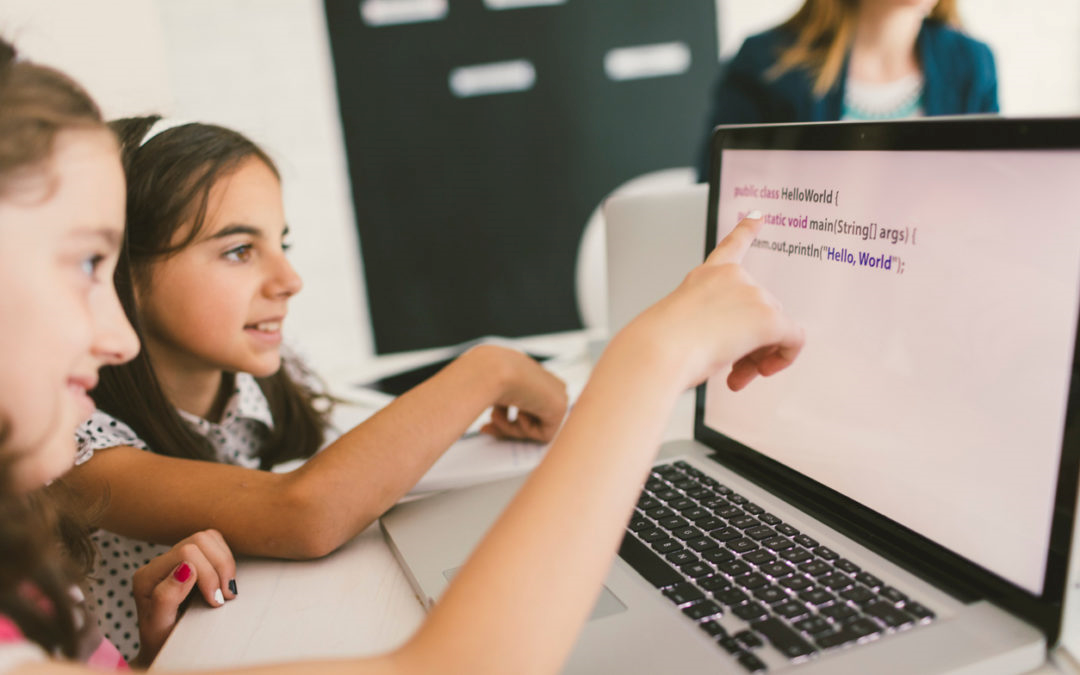
 We are an army of educators and passionate learners from BrightChamps family, committed to providing free learning resources to kids, parents & students.
We are an army of educators and passionate learners from BrightChamps family, committed to providing free learning resources to kids, parents & students.









